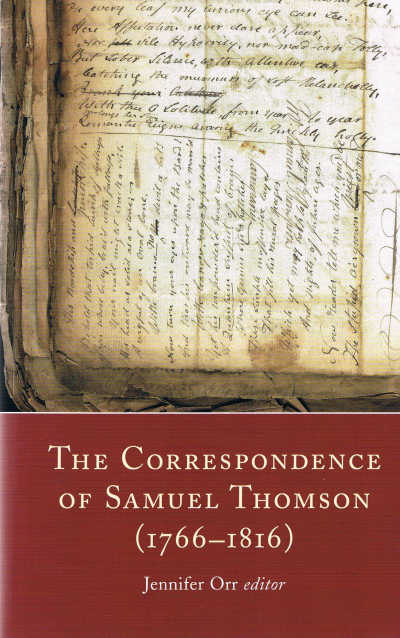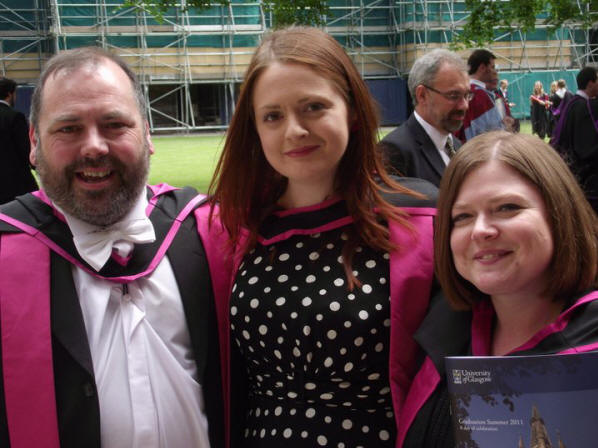|
Edited
by Frank R. Shaw, FSA Scot, Dawsonville, GA, USA
Email:
jurascot@earthlink.net
 This
has been a fun book to read and writing the book review has been equally
enjoyable! It weaves an interesting story of a group of Irish poets
corresponding with each other. A big topic of conversation among some of
them is the Scottish poet Robert Burns. The poets write about books, buying
and borrowing them, “the expense of postage”, and ‘the selfish consideration
that the sooner I write to you, the sooner I will be gratified with the
receipt of a letter from you”. Naturally their writings are about each
others books or poetry and the political situation where writing by code
became, for obvious reasons, the order of the day for some of them. This
has been a fun book to read and writing the book review has been equally
enjoyable! It weaves an interesting story of a group of Irish poets
corresponding with each other. A big topic of conversation among some of
them is the Scottish poet Robert Burns. The poets write about books, buying
and borrowing them, “the expense of postage”, and ‘the selfish consideration
that the sooner I write to you, the sooner I will be gratified with the
receipt of a letter from you”. Naturally their writings are about each
others books or poetry and the political situation where writing by code
became, for obvious reasons, the order of the day for some of them.
The relationships of the inner circle seems to
border on the ‘you buy mine and I’ll buy yours” scenario or the “here is a
list of subscribers for your book or your poem, and I hope you can do the
same for me” idea. One poet interjects a time limit on how long his friend
can borrow his book, three months actually, and it must be returned by
August 1st which comes and goes – another reminder is sent - and
then another later on. I have found no record the book was ever returned.
Lesson? Be careful who you loan your books to, even good friends, much less
your family! The correspondence of this circle of bards centered on Samuel
Thomson’s cottage, Crambo Cave. Thomson was the one at the center of the
poets group and was described as “the father of a northern school of Irish
poets.”
But all is not fun and games in this book by
Jennifer Orr, and soon tension builds concerning the political climate in
Ireland. Before too long a few of the poets find themselves living in
Philadelphia or Charleston or other countries for their own safety as well
as that of their families. Unfortunately an execution or two takes place,
cooling the radical arguments about freedom from some of them, Thomson
included. The poetry they write raises eyebrows and the government takes
action against some of them after they publish their poems in newspapers
like the Northern Star, a radical United Irishmen publication which
has its press destroyed. Thomson is described as “practically the poet
laureate” of the newspaper.
His friend James Dalrymple felt the Irish
political situation would mean “much blood (to) be spilt before you enjoy
political freedom and whether it is worth the sacrifice you in Ireland must
judge.” Again, some in the group paid with their lives! The 1798 Rebellion
was a trend setter, and they were aware of the thin ice they walked upon
leaving Thomson and others in the circle more cautious about publishing
their writings from then on. The United Irish Movement was not so united but
the United Kingdom was.

Editor, Dr. Jennifer Orr
For Burnsians like myself, lay people, I found
the correspondence about Burns to be exciting because these poets were
contemporaries of his and their comments make the book come alive as they
discuss Burns just as you and I would discuss a friend among our own circle
of acquaintances. Let’s take a look at a few instances regarding Burns and
these poets as we skip among the references.
Burns received a couple of letters from Thomson
discussing political subjects, thus reminding us that both were radicals at
times.
Samuel Thomson found his way from Co. Antrim to
Dumfries in 1794 to meet with Burns in his home and he leaves with several
original poems by Burns, among them was Clarinda, Mistress of My Soul.
You have to wonder what political topics were discussed by these two
outspoken men.
Packet boat owner James Lemon carried a number
of parcels to Burns from Thomson, but unfortunately there is no mention of
what they contained.
Here is an interesting item. Did Burns dip snuff
? Either he did or he passed it on to someone because mention is made of
suggestion to “send him a pound of snuff known by the name of Blackguard.
Lundy Fool in Dublin is the famous Manufacturer of it.” This occurred in
1791 and we know Thomson also sent another packet of snuff to Burns in March
1794. (It is reported that Burns requested the first gift of snuff after
giving Thomson a copy of Fergusson’s POEMS.)
John Rabb, another Irish poet, writes Thomson
asking “will you call and tell me where Burns lives now?” as Rabb is
interested in opening correspondence with Burns.
Evidently James Hogg was not the only one who
felt he could replace Burns as Thomson would later market himself as the
successor to the Scottish bard just as Burns felt he could establish himself
as Fergusson’s successor.
Our old friend William Magee shows his ugly head
in the book as a Belfast printer working with Thomson and other poets
publishing their works. Those familiar with Magee know he pirated the works
of Burns and published them in Ireland with poor Burns never receiving a
penny. The greedy Magee got it all!
Burns actually met Irish poet Thomas Sloan while
traveling from Ayrshire to Ellisland and a delightful friendship developed.
Burns later had to inform Sloan that he was unable to resolve financial
assistance Sloan needed when Burns turned to John Ballantine on behalf of
Sloan.
John Gillespie visited Burns carrying snuff from
Thomson. “I’m just going to scold Mr. Burns this mail”, Thomson wrote, but
nothing in Thomson’s letters backs up his claim of scolding Burns. Thomson
does pen the words of Italian poet Ariosto at the end of this letter saying,
“No form so graceful can your eyes behold / For nature made him and
destroy’d the mould.”
In a post script, Luke Mullan writes this to
Thomson: “I have seen Mr. Burns and spoke to him…I endeavoured to learn as
much about his character as possible - he is not much respected in Dumfries
on account of his infidelities to his wife - but as an officer of the excise
he is said to be very humane to poor people. I believe he writes little now
- he offers some to the Dumfries Papers and is not accepted - so little are
great men thought in their own country and in their lifetime…”
I must conclude with these little gems about
Burns and refer you to the book where the beat goes on and on and moves,
according to John Gray, from “adulation to discord”.
This is a magical book, and Jennifer Orr has
done a masterful job of portraying the relationship between these Irish
poets as well as their relationship to Burns in their correspondence. In
response to an email of mine, Jennifer wrote, “I too was amazed at the
reflections on Robert Burns contained within and, particularly, the idea
that Thomson may have had a key role in shaping the Bard’s reputation in
Ireland.” Indeed he did. BUT, you should remember there is much more to this
book than just the relationship between the Irish poets and Robert Burns.
Much more! (FRS: 5.4.12)
Now I want to share with
you some of Jennifer’s thoughts which will be a great asset to you regarding
The Correspondence of Samuel Thomson. In an email dated April 30th,
Jennifer wrote…

L-R: Dr. Gerard Carruthers, Dr. Jennifer Orr
upon receiving her PhD, and Dr. Rhona Brown, all from the University of
Glasgow.
Regarding your questions for the article, my
attraction both to Burns and the Ulster poets was strongly rooted in a
shared sense of mixed identity. Scottish and Irish heritage has always been
strongly bound up together in Ulster and, like Samuel Thomson; I have always
had a strong sense both of my Irish and Scottish heritage. Names within my
family include Shields (which I'm told is a Donegal name), Bell, Campbell,
Mechan and Duncan. Most of them had been around in Ulster for centuries but
the latter were coal merchants from Scotland and moved to Ireland in the
Victorian ear when Belfast became a central industrial city within the
British Empire.
We grew up
in Bangor, County Down, just 12 miles across the North Channel from Scotland
where the hills of the Galloway peninsula can be seen on a clear day. My
grandparents took my mother and aunt on holiday to Ayrshire, visiting Robert
Burns's cottage in Alloway, which seemed to be a frequent site of pilgrimage
for Ulster holiday makers. Robert Burns was as natural a part of my literary
heritage as William Shakespeare or William Yeats. I had little trouble
understanding the Scots language as I had heard variants of it spoken in
rural parts of Ulster.
While I was an undergraduate at Oxford, I studied Anglo-Saxon and medieval
literature but when it came to researching my undergraduate thesis, I
fancied doing something different and closer to home. I decided to write on
the topic of Irish poetry and to explore something that was personal to me.
My aunt Dr Carol Baraniuk had taken a secondment from her job as a school
teacher to work on a project with the Ulster Scots Academy at Stranmillis
College Belfast and told me of an exciting tradition of eighteenth- and
nineteenth-century Ulster poets who wrote in the language of the people.
She was particularly interested in the poet James Orr and was about to
embark on a PhD at the University of Glasgow. She mentioned that Orr's
friend and fellow poet Samuel Thomson was also an interesting figure who had
corresponded with Robert Burns.
The research that we were undertaking coincided with an exciting resurgence
of Scottish Literary studies at the University of Glasgow on the approach to
the Bicentenary of Robert Burns's birth. In May 2005 I traveled to Glasgow
to meet with Professor Gerry Carruthers who agreed to supervise a doctoral
thesis on Samuel Thomson pending my successful graduation from Oxford. Two
years later, I was successful in obtaining funding and from 2007 played a
full and active role in the exciting intellectual environment of the
Glasgow's Department of Scottish Literature, where I was also able to gain
teaching experience while undertaking research. Following my viva in May
2011, I produced The Correspondence of Samuel Thomson.
Five years ago, even those familiar with Irish literature would have
struggled to name more than five Ulster poets. Heaney, certainly. Maybe
Michael Longley and John Hewitt. In fact, it has been a commonly-held belief
that the Romantic period missed Ulster completely. While Robert Burns was
active in Scotland, why should there not have been a similar movement in
Ulster, particularly when the newspapers were full of revolutionary and
nationalist verse? Many of Thomson's poems are as good as Burns's and some
might even be better, like the masterful political allegory 'To a Hedgehog'
and 'O Scotia's Bard, my muse alas!', Thomson's skilful parody of Burns's
'Does Haughty Gaul Invasion Threat?
To a
Hedgehog
Samuel Thomson
Thou grimmest far o gruesome tykes
Grubbin thy food by thorny dykes
Gude faith, thou disna want for pikes
Baith sharp and rauckle;
Thou looks (Lord save's) arrayed in spikes,
A creepin heckle.
Sure Nick begat thee, at the first,
On some auld whin or thorn accurst;
An some horn-fingered harpie nurst
The ugly urchin;
Then Belzie, laughin like to burst,
First caad thee Hurchin.
Fowk tell how thou, sae far frae daft,
Whan wind-faan fruit be scattered saft,
Will row thysel wi cunning craft
An bear awa
Upon thy back, what fares thee aft,
A day or twa.
But whether this account be true
Is mair than I will here avow;
If that thou stribs the outler cow,
As some assert,
A pretty milkmaid, I allow,
Forsooth thou art.
Now creep awa the way ye came,
And tend your squeakin pups at hame;
Gin Colly should oerhear the same,
It might be fatal,
For you, wi aa the pikes ye claim,
Wi him to battle.
Both poets
shared a belief in the common humanity of all men regardless of class status
and exploited their hybrid knowledge of the Scots and English languages to
contribute to the rich cultural tapestry of Scottish and Irish identity
within a dislocating British constitutional context. Thomson consolidated a
group of writers during the Irish revolutionary period 1790-1798 as a means
of resisting the British state but once the Anglo-Irish Union came about in
1801, he modified his tactics to preserve Irish identity by promoting her
unique artistic and cultural status. Thomson was deeply in tune with the
print culture of his day and he knew that cultural identity was a complex
and unstable concept and could include a range of identities. His pragmatic
poetic response to turbulent historical events preserved a sense of Irish
dissenting nationalist culture that might have been swallowed into the
cultural stereotypes of Prostestant-unionist and Catholic-nationalist which
are so familiar to us from the troubled Twentieth Century.
Sorry - a bit of an essay for you here - but hopefully it will be useful!
Thank you, Jennifer, for
sharing your book as well as yours thoughts with us. This is a subject that
was begging to be presented. |

